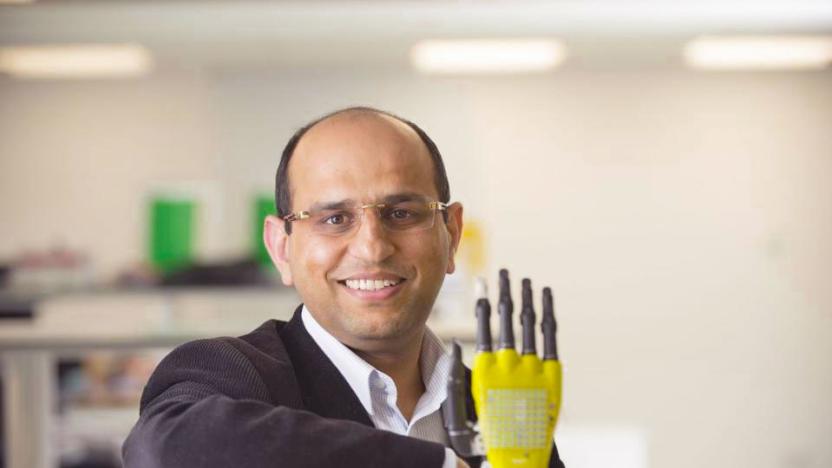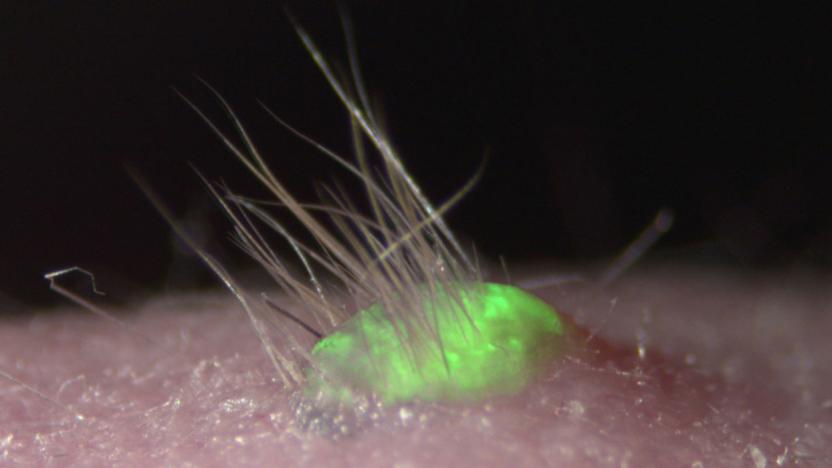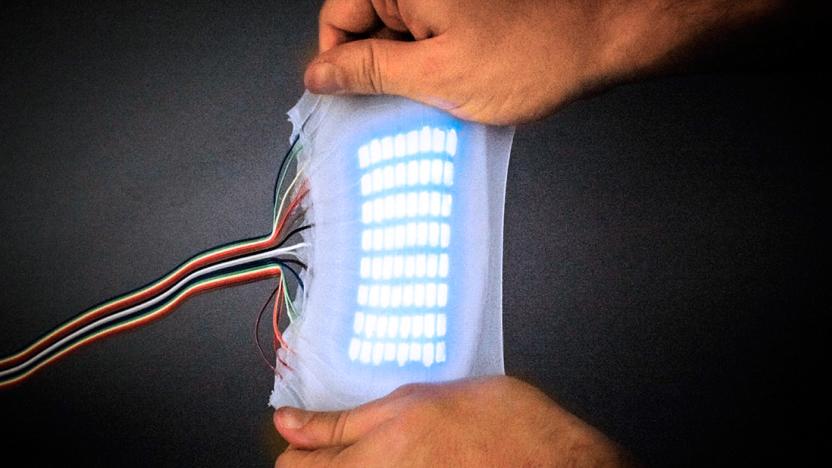ArtificialSkin
Latest

Jellyfish-inspired e-skin glows when it's in 'pain'
Artificial skin stands to have a variety uses, with potential applications in everything from robots to prosthetics. And in recent years, researchers have been able to instill sensory perception, like touch and pressure, into artificial skin. However, while those sorts of senses will be incredibly important in engineered skin, they've so far been rather limited. For example, while current versions can be quite sensitive to light touch, they don't fare so well with high pressures that could cause damage. So researchers at the Huazhong University of Science and Technology in China set out to fix that problem and they drew their inspiration from jellyfish.

Artificial skin with solar cells could power prosthetics
Researchers at Glasgow University have successfully developed a new type of artificial skin that is more sensitive than our own. Made of just a single atomic layer of graphene, the new soft feeling epidermis functions as its own sophisticated touch sensor. If that wasn't impressive enough, this artificial 'skin' is also entirely self-powered. Housing a solar panel hidden under its graphene layer, the material manages to absorb over 98 percent of the light available, relying only on the sun to power it.

ICYMI: Hairy robots are better than smooth
try{document.getElementById("aol-cms-player-1").style.display="none";}catch(e){}Today on In Case You Missed It: Roboticists from China created an artificial skin for robots that simulate hair with glass-shrouded microwires. A gripper hand with the 'hair' on it's skin was able to feel when an object was slipping because of the hair, then adjust its grip. Lets just hope they keep the full Teenwolf under control. The helium-filled balloon bot designed for search and inspection jobs is here. Meanwhile NASA is spending its final days of 2016 by releasing data visualizations of carbon dioxide pollution around the globe, and how extra heat is stored in the world's oceans. The Chuck E. Cheese challenge video is here and that awkward handshake, here. As always, please share any interesting tech or science videos you find by using the #ICYMI hashtag on Twitter for @mskerryd.

Artificial skin grows hair and sweat glands
You've probably seen artificial skin before, but never has it been quite so... accurate. Japanese researchers have grown skin tissue that not only includes hair follicles, but all the glands that come with it -- including oil and sweat glands. The trick was to take cells from mouse gums, turn them into stem cell-like forms that generate skin, and implant those into mice with immune system deficiencies (which lets the new skin grow unimpeded). The resulting skin was a little creepy -- just look at the wart-like growth above -- but it was healthy, behaved normally and made connections with natural tissue.

Robots could get soft, stretchable skin that changes colors
Researchers from Cornell University have developed a potential skin material that lights up and stretches to more than six times its original size. The so-called hyper-elastic, light-emitting capacitors (HLECs) are made from transparent hydrogel electrodes wrapped around an insulating dielectric sheet, allowing them to light up when stretched or rolled. Since the skin can handle twice as much strain as earlier materials, it could function as a skin for soft robots that light up to display "emotions."

Stanford researchers make artificial skin that senses touch
A team from Stanford University might have made a breakthrough that could change the lives of people with missing limbs. Researchers have developed an artificial substitute for skin that is capable of sensing when it is being touched and sending that data to the nervous system. It's hoped that technology like this could be used to build futuristic prostheses that could be wired into the nervous systems of amputees. In addition, not only will these people be able to know if they're touching something, they'll also know how much pressure is being used.

Artificial sense of touch gets smarter, lets robots really feel
The verdict's still out on whether or not androids dream of electric sheep. But their ability to feel? Well, that's about to approach levels of human sensitivity. We're of course talking about the sense of touch, not emotions. And thanks to work out of Georgia Tech, tactile sensitivity for robotics, more secure e-signatures and general human-machine interaction is about to get a great 'ol boost. Through the use of thousands of piezotronic transistors (i.e., grouped vertical zinc oxide nanowires) known as "taxels," a three-person team led by Prof. Zhong Lin Wang has devised a way to translate motion into electronic signals. In other words, you're looking at a future in which robotic hands interpret the nuances of a surface or gripped object akin to a human fingertip and artificial skin senses touch similar to the way tiny hairs on an arm do. What's more, the tech has use outside of robotics and can even be levereged for more secure e-signature verification based on speed and pressure of a user's handwriting. And the best part? These sensors can be manufactured on transparent and flexible substrates like the one pictured above, which allows for various real-world applications -- just use your imagination. Pretty soon, even robots will have the pleasure of enjoying the touch... the feel of cotton and maybe even hum that jingle to themselves, too.

Canadian researchers aim to build a more life-like robot, one piece at a time
It may not be all that human-like in its current state, but a team of researchers at the University of Ottawa are promising that this robot will get there sooner or later. Dubbed "Pumpkin," the bot will apparently have its parts replaced piece-by-piece with more life-like counterparts over time, including parts that make use of a new artificial skin the researchers have developed. It not only includes the usual array of sensors that give the robot some degree of tactile sensitivity, but a network of tubes that circulate hot water to actually increase the temperature of the skin. According to the researchers, the eventual goal is to have a robot that appears and behaves naturally enough to make humans feel at ease when they're interacting with it, but it might get a bit worse before it gets better -- the next step is to replace the head with an anatomically correct model of the human skull, which will have the aforementioned artificial skin stretched over it. [Thanks, Jeff]

Stanford builds super-stretchy skin sensor out of carbon nanotubes (video)
An artificial skin that senses pressure, pinches and touch sounds like a macguffin from The Outer Limits (the episode "Valerie 23" if we recall correctly), but that's what a team from Stanford University has cooked up on the back of its pick-up truck. Sensors made of silicon films with a matrix of liquid carbon nanotubes ensure the material snaps back to its original shape no matter how frequently it's pulled about. When compressed, the electrical conductivity of the skin changes, and by measuring where and by how much, it knows the location and pressure of where you jab your fingers. The team wants to combine this super stretchy film with a much more sensitive sensor and if it can do it, then the technology could end up as an artificial skin for burn victims, covering prosthetic limbs or even replacing your multitouch display -- just be careful, you might hurt Siri if you pinch-to-zoom her too hard.

UC Berkeley researchers craft ultra-sensitive artificial skin, robots dream of holding eggs
Researchers and engineers have been toiling on synthetic skins for years now, but most of 'em have run into one major problem: the fact that organic materials are poor semiconductors. In other words, older skins have required high levels of power to operate, and those using inorganic materials have traditionally been too fragile for use on prosthetics. Thanks to a team of researchers at UC Berkeley, though, we're looking at a new "pressure-sensitive electronic material from semiconductor nanowires." The new 'e-skin' is supposedly the first material made out of inorganic single crystalline semiconductors, and at least in theory, it could be widely used in at least two applications. First off, robots could use this skin to accurately determine how much force should be applied (or not applied, as the case may be) to hold a given object. Secondly, this skin could give touch back to those with artificial hands and limbs, though that would first require "significant advances in the integration of electronic sensors with the human nervous system. Dollars to donuts this gets tested on the gridiron when UCLA and / or Stanford comes to town.








